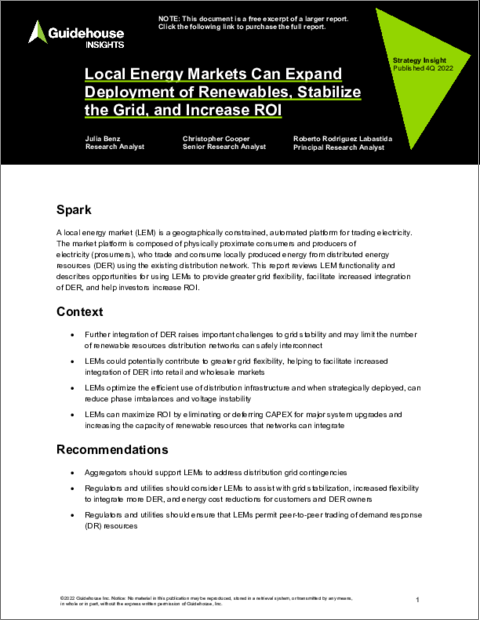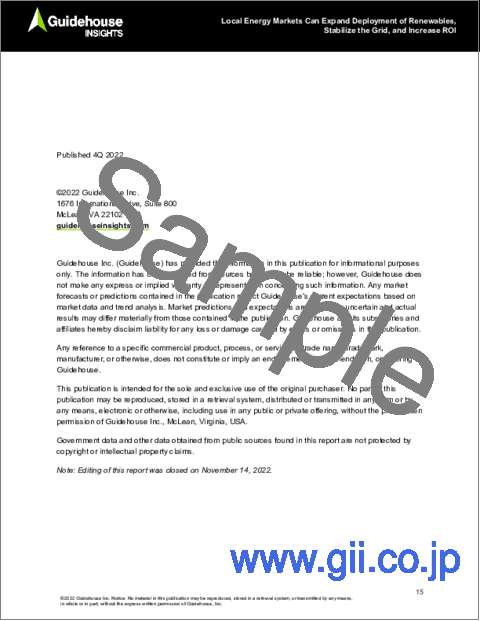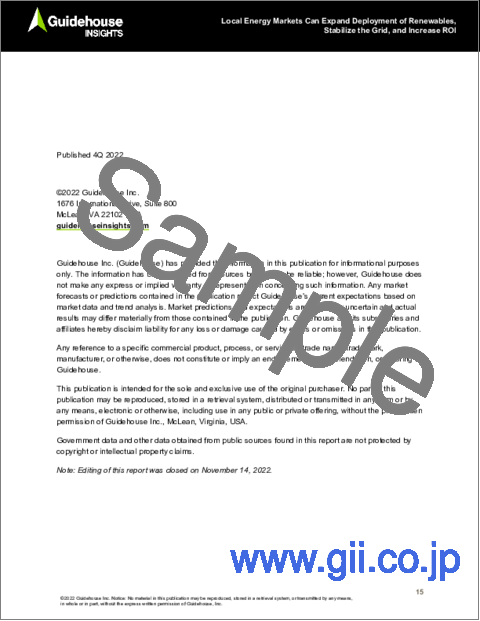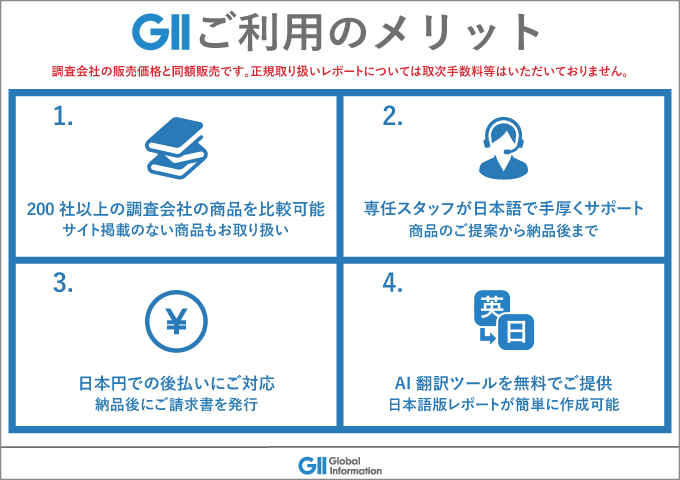|
|
市場調査レポート
商品コード
1158456
再生可能エネルギーの導入を拡大し、グリッドを安定させ、ROIの向上を可能にするローカルエネルギーマーケット(LEM)Local Energy Markets Can Expand Deployment of Renewables, Stabilize the Grid, and Increase ROI |
||||||
| 再生可能エネルギーの導入を拡大し、グリッドを安定させ、ROIの向上を可能にするローカルエネルギーマーケット(LEM) |
|
出版日: 2022年11月15日
発行: Guidehouse Insights
ページ情報: 英文 15 Pages; 6 Tables, Charts & Figures
納期: 即納可能
|
- 全表示
- 概要
- 図表
- 目次
ローカルエネルギーマーケット(LEM)は、地理的に制約された、自動化された電力取引プラットフォームです。自動化されたLEMプラットフォームは、配電網の特定部分における需要と供給のバランスを取ることを目的に、複数の買い手と売り手の間でピアツーピア(P2P)またはサードパーティアグリゲーターを介した取引を促進します。また、バッテリーエネルギー貯蔵システムの利用が増えれば、グリッドの輸出入を大幅に減らすことができます。その結果、蓄電によってLEMと配電網の間の取引回数が大幅に減少し、グリッドの安定性強化に貢献します。
当レポートでは、ローカルエネルギーマーケット(LEM)を調査し、LEM機能のレビュー、LEMを使用したグリッドの柔軟性の向上、DERの統合促進、投資家がより大きなROIを実現できるようにする機会などの情報を提供しています。
目次
序文
背景
提言
ローカルエネルギーマーケット(LEM)の仕組み
DER統合の増加により、送配電の重大な課題が発生
- 普及が進むにつれ、再生可能エネルギーDERは通常の経済配分を混乱させ、ネット負荷のダックカーブを引き起こす可能性がある
適切に設計されたLEMは、ダックカーブの解消とクリーンエネルギーの削減を支援する
- DR取引の許可が市場ベースの削減を可能にする
- ダイナミックな位相切り替えにより配電ネットワークを安定させ、輻輳ベースの削減を可能にする
LEMはプロシューマーと配電事業者に経済的利益をもたらす
- LEMはグリッドの柔軟性に対する電力支出を相殺する
- LEMはネットワーク容量のアップグレードを延期できる
LEMパイロット事業のケーススタディは重要な教訓を提供する
- 米国:Brooklyn Microgrid
- ドイツ:Pebbles Project
- オランダ:Hoog Dalem Stedin Pilot Project
- 英国:Cornwall Project
LEMの導入は、適切なガイダンスにより、エネルギー転換を加速させる
List of Tables
- DER Versus Centralized Generation Capacity, World Markets: 2022-2031
California Wholesale Energy Market Net-load Duck Curve
Typical All-India Demand vs. Net Peak-day Demand
DSO CAPEX Budgets: Example from Australian DSO with High DER Penetration
Simplified Schematic Demonstrating How a Typical LEM Works
Net Electricity Demand in the Netherlands by Month, 2016-2021
List of Figures
- DER Versus Centralized Generation Capacity, World Markets: 2022-2031
California Wholesale Energy Market Net-load Duck Curve
Typical All-India Demand vs. Net Peak-day Demand
DSO CAPEX Budgets: Example from Australian DSO with High DER Penetration
Simplified Schematic Demonstrating How a Typical LEM Works
Net Electricity Demand in the Netherlands by Month, 2016-2021
A local energy market (LEM) is a geographically constrained, automated platform for trading electricity. The market platform is composed of physically proximate consumers and producers of electricity-prosumers-who trade and consume locally-produced energy from distributed energy resources (DER) using the existing distribution network.
An automated LEM platform facilitates trading-either peer-to-peer (P2P) or through third-party aggregators-between multiple buyers and sellers with the goal of balancing supply and demand in a particular part of the distribution grid. Additionally, the increased utilization of battery energy storage systems significantly reduces grid exports and imports. In turn, storage substantially reduces the number of transactions between the LEM and the distribution network, contributing to enhanced grid stability.
This report reviews LEM functionality and describes opportunities for using LEMs to provide greater grid flexibility, facilitate increased integration of DER, and help investors realize greater ROI
Table of Contents
Spark
Context
Recommendations
How Local Energy Markets Work
Increased DER Integration Raises Significant Transmission and Distribution Challenges
- At Greater Penetrations, Renewable DER Can Disrupt Normal Economic Dispatch, Causing a Net-load Duck Curve
Properly Designed, LEMs Can Help Solve the Duck Curve and Reduce Curtailment of Clean Energy
- Permitting DR Trading Reduces Market-based Curtailment
- Dynamic Phase Switching Stabilizes Distribution Networks and Reduces Congestion-based Curtailment
LEMs Produce Financial Benefits for Prosumers and Distribution Utilities
- LEMs Offset Utility Expenditures on Grid Flexibility
- LEMs Can Defer Network Capacity Upgrades
Case Studies of LEM Pilot Projects Provide Critical Lessons
- USA: Brooklyn Microgrid
- Germany: Pebbles Project
- Netherlands: Hoog Dalem Stedin Pilot Project
- UK: Cornwall Project




